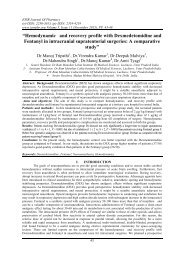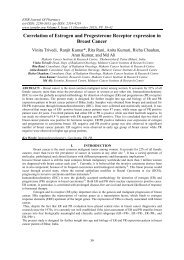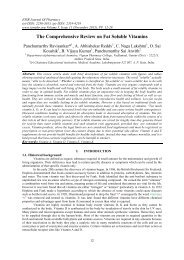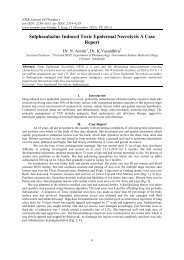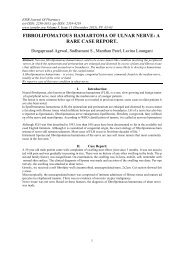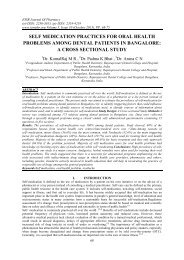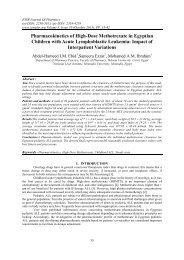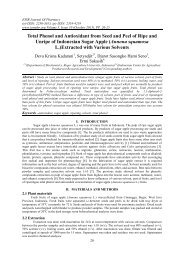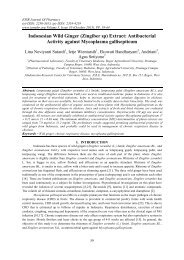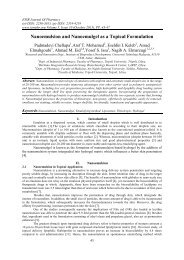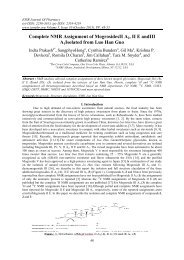The Effect Of Roselle Extract (Hibiscus Sabdariffa Linn.) On Blood Glucose Level And Total Antioxidant Level On Diabetic Rat Induced By Streptozotocin
You also want an ePaper? Increase the reach of your titles
YUMPU automatically turns print PDFs into web optimized ePapers that Google loves.
<strong>The</strong> <strong>Effect</strong> <strong>Of</strong> <strong>Roselle</strong> <strong>Extract</strong>…<br />
<strong>Roselle</strong> (<strong>Hibiscus</strong> sabdariffa <strong>Linn</strong>.) has been believed for many years to be able to reduce the risk of<br />
degenerative diseases. Several studies have shown that roselle was effective in lowering blood pressure<br />
([11];[12];[13];[14];[15]), had an antioxidant function protecting the liver from a damage ([16];[17];[18];[19]),<br />
increased the antioxidant enzymes in the liver [20], was anti-inflammatory and analgesic [21], and was found to<br />
lower uric acid ([22];[23]). <strong>Roselle</strong> has high antioxidant content. <strong>The</strong> highest components in roselle are<br />
anthocyanins, a flavonoid group. Anthocyaninsfound in roselle are delphinidin-3-sambubioside, cyanidin-3<br />
sambubioside, and delphinidin-3- glucose [24]. Beside anthocyanins, it also contains alkaloids, L- ascorbic acid<br />
, anisaldehid, β-carotene,β-sitosterol, citric acid, galactose, gossypetin, hibiscetin, and mucopolysaccharides<br />
[25].<br />
ROS or free radicals can be neutralized and destroyed by antioxidants present in the body so that the<br />
biological damage by these compounds can be avoided [6]. <strong>The</strong> purpose of the research was to evaluate whether<br />
roselle would increase the antioxidants in the body, reduce oxidative stresand improve insulin production in<br />
diabetic rats induced by streptozotosin.<br />
II. MATERIALS AND METHODS<br />
2.1 <strong>Roselle</strong> <strong>Extract</strong>ion<br />
Petals of purple roselle (<strong>Hibiscus</strong> sabdariffa <strong>Linn</strong>.) were obtained from Leuwiliang plantation, Bogor,<br />
West Java. Fresh roselle was dried using oven with a temperature of 60 o C for 6 hours. Dried roselle were then<br />
boiled with water for 10 minutes at a concentration of 2g/200 ml. <strong>Roselle</strong> extract was concentrated 10 ml by<br />
vacuum evaporator and stored at 4°C.<br />
2.2 Experimental Animals<br />
All animal experimental protocol used in this study was approved by Health Development and<br />
Research Committee, Health Ministry, Republic of Indonesia with ethical clearance<br />
No.LB.02.01/5.2/KE.446/2013. Male Sprague Dawley (SD) rats (200 ±30 g), 8 weeks old, used in the studies<br />
were purchased from BPPOM (National agency for drug and food control), Jakarta. All animals were housed<br />
in laboratory conditions for one week before experiments began. <strong>Rat</strong>s were allowed free access to drinking<br />
water (ad libitum) and were maintained at a constant temperature of 24-26 o C and 50–60% relative humidity<br />
conditions. Before the experiment, rats were adapted to the laboratory diet [26] for 7 days.<br />
2.3 Diabetes Induction<br />
<strong>Diabetic</strong> condition of rats was induced experimentally by intraperitoneal injection of freshly prepared<br />
streptozotocin (STZ)(Sigma,USA) solution at a dose of 30-35 mg/kg body weight in 0.1M cold citrate buffer,<br />
pH 4.5 [27]. <strong>Blood</strong> was collected from the tail vein after 72 h and glucose levels were determined using<br />
glucometer test kit. Animals were considered diabetic if the testing blood glucose values were always above<br />
200 mg/dl. If blood glucose levels did not reach>200mg/dl, then rats were re-injected with the same dose of<br />
streptozotosin. Control rats received citrate buffer (pH 4.5) alone.<br />
2.4 Experimental Design<br />
<strong>Rat</strong>s were randomly divided into six groups, (four rats per group). In group one (SG): the rats were not<br />
induced by STZ, and were given drinking water only. In group two (DiG) diabetic rats were given<br />
glibenklamide 0.09 mg/day/200 g bw; In group three (DiW) diabetic rats were given drink water only. In group<br />
four (PR1) rats were treated with roselle extract 2 ml/day (for 2 ml contains 72 mg/day/200 g bw) for 10 days<br />
prior to injectioned with STZ, and then treated with roselle extract until 21th day. In group five (DiR1), diabetic<br />
rats were treated with roselle extract (72 mg/day/200g bw). In group six (DiR2) diabetic rats were treated with<br />
roselle extract 2 ml/day (for 2 ml contains 288 mg/day/200g bw). <strong>The</strong> roselle extract was administered 2<br />
ml/day by orally. Feed was given approximately 25 g/rat/day. During treatment period glucose levels were<br />
measured 2 to 3 times in all groups of treated rats.<br />
At the end of the treatment period, all rats were anaesthetized with ether and the body was cleaned by<br />
alcohol. Further, the peritoneal was opened, and blood sampling by using the syrinx. <strong>Blood</strong> of rats from each<br />
group was collected and centrifuged at 1870 g for 15 min at 4°C. <strong>Rat</strong> body organs were washed in a PBS<br />
(phosphate buffered saline) solution, drained, and weighed. <strong>The</strong> organs were then wrapped in aluminum foil and<br />
stored in a freezer at -20ºC [28].<br />
9




